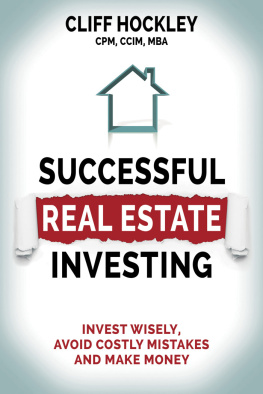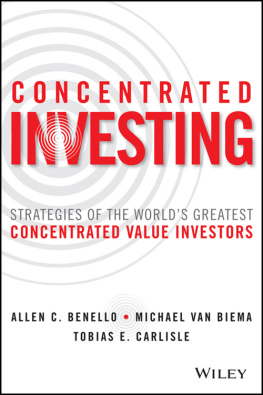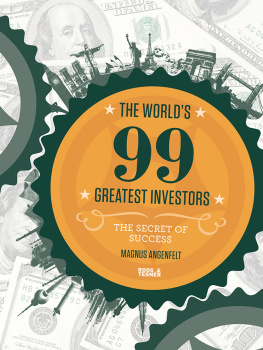
Copyright 2012 by Stephen L. Weiss. All rights reserved.
Published by John Wiley & Sons, Inc., Hoboken, New Jersey.
Published simultaneously in Canada.
No part of this publication may be reproduced, stored in a retrieval system, or transmitted in any form or by any means, electronic, mechanical, photocopying, recording, scanning, or otherwise, except as permitted under Section 107 or 108 of the 1976 United States Copyright Act, without either the prior written permission of the Publisher, or authorization through payment of the appropriate per-copy fee to the Copyright Clearance Center, Inc., 222 Rosewood Drive, Danvers, MA 01923, (978) 750-8400, fax (978) 646-8600, or on the Web at www.copyright.com. Requests to the Publisher for permission should be addressed to the Permissions Department, John Wiley & Sons, Inc., 111 River Street, Hoboken, NJ 07030, (201) 748-6011, fax (201) 748-6008, or online at http://www.wiley.com/go/permissions.
Limit of Liability/Disclaimer of Warranty: While the publisher and author have used their best efforts in preparing this book, they make no representations or warranties with respect to the accuracy or completeness of the contents of this book and specifically disclaim any implied warranties of merchantability or fitness for a particular purpose. No warranty may be created or extended by sales representatives or written sales materials. The advice and strategies contained herein may not be suitable for your situation. You should consult with a professional where appropriate. Neither the publisher nor author shall be liable for any loss of profit or any other commercial damages, including but not limited to special, incidental, consequential, or other damages.
For general information on our other products and services or for technical support, please contact our Customer Care Department within the United States at (800) 762-2974, outside the United States at (317) 572-3993 or fax (317) 572-4002.
Wiley also publishes its books in a variety of electronic formats. Some content that appears in print may not be available in electronic books. For more information about Wiley products, visit our web site at www.wiley.com.
Library of Congress Cataloging-in-Publication Data:
Weiss, Stephen L., 1955
The big win : learning from the legends to become a more successful investor/ Stephen Weiss.
p. cm.
Includes bibliographical references and index.
ISBN 978-0-470-91610-0 (cloth); ISBN 978-1-118-22127-3 (ebk);
ISBN 978-1-118-23358-0 (ebk); ISBN 978-1-118-25971-9 (ebk)
1. InvestmentsUnited States. 2. Portfolio managementUnited States. I. Title.
HG4910.W3678 2012
332.60973dc23
2012004093
To Lauren, Shelby, and Lindsay
My BIGGEST WINS
Disclosure
Data from various sources was used in the preparation of this book. The information is believed to be reliable, accurate, and appropriate, but it is not guaranteed in any way. The forecasts and strategies contained herein are statements of opinion, and therefore may prove to be inaccurate. They are in fact the authors own opinions, and payment was not received in any form that influenced his opinions. Stephen L. Weiss implements many of the strategies described. This book contains the names of some companies used as examples of the strategies described, but none can be deemed recommendations to the books readers. These strategies will be inappropriate for some investors, and we urge you to speak with a financial professional and carefully review any pertinent disclosures before implementing any investment strategy. This book has been prepared solely for informational purposes, and it is not an offer to buy or sell, or a solicitation to buy or sell, any security or instrument, or to participate in any particular trading strategy. Investment strategies described in this book may ultimately lose value even if the opinions and forecasts presented prove to be accurate. All investments involve varying amounts of risk, and their values will fluctuate. Investments may increase or decrease in value, and investors may lose money.
Acknowledgments
It seems that no matter what I set out to do, my wife, Lauren, is the critical component in my getting there. Always a great sounding board, she is also a wonderful editor, excellent illustrator, and all-around good sport. As with most all else that I have accomplished, I could not have written this book without her partnership and love. As we came down to the finish line, Lauren was also finally willing to own up to the fact that our beautiful, incredibly intelligent daughters take after me more than her, but I think that had everything to do with how they approach their schoolwork, and my missing the submission date for this book, and nothing to do with their better qualities. My aforementioned daughters, Lindsay and Shelby, were very understanding about the time commitment required to write this book and their enthusiasm about the project kept me enthused as well. They promised me that they would read this one, but Im not going to hold out too much hope. Susanna Margolis once more proved herself to be the best of the best as far as editors and confidants go. My in-laws, Harriet and Irwin Karassik, and sister-in-law, Beth, who, in addition to being responsible for making Lauren the person she is, were incredibly helpful in providing feedback on each chapter. Debby Englander at John Wiley & Sons was again extremely supportive, patient, and encouraging. I appreciate her continuing to have faith in me and my ability to write another well-received investment book. I hope shes right. Thank you, Debby. The entire staff at Wiley makes my job as an author very easy; Kimberly Bernard, Donna Martone, and Tula Batanchiev were very helpful. My appreciation also extends to Andrew Stuart, my agent, for continuing to represent my nonfiction efforts and getting my work in print. And of course a special thank you to all those who so graciously allowed me into their lives: Lee Ainslie, Jim Chanos, Alfred Taubman, Chuck Royce, Marty Whitman, Don Peebles, Rene Haugerud, and Jim Rogers. These very successful individuals gave me as much time as needed and could not have been more open during the process.
S.W.
Introduction
If you have flipped open the cover of this book, or tapped the screen on your iPad or Kindle to arrive at this introduction, I hope you wont be disappointed by not having found another dry, dull how-to book on investing. The Big Win: Learning from the Legends to Become a More Successful Investor has been written to read like a collection of entertaining short stories while providing invaluable insights, culled from the experiences of some of the best investors in the business, that you can integrate into your investment strategy in order to drive greater profitability.
My first book, The Billion Dollar Mistake: Learning the Art of Investing Through the Missteps of Legendary Investors (John Wiley & Sons, January 2010), profiled 11 top investors, their life stories, their paths to success, and their biggest mistakes. While virtually all investment books lay out a step-by-step strategy that, if adhered to, will allow for the achievement of financial independence or success beyond your wildest dreamssarcasm intentional The Billion Dollar Mistake is unique in its approachfocusing on what not to do. It is a dont do what I did and get rich kind of book. The mistakes in each chapter are the garden-variety missteps that we all make, investors big and small, the only difference being the number of zeros to the left of the decimal point. In fact, most professional investors assiduously relive their mistakes, dissecting them over and over both as involuntary penance and, more productively, in an effort to understand what went wrong so that it doesnt happen again. George Santayana put it best when he said: Those who cannot remember the past are condemned to repeat it.
Next page






